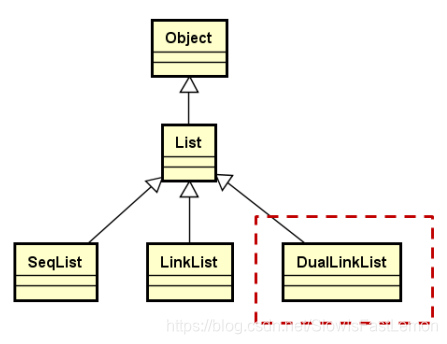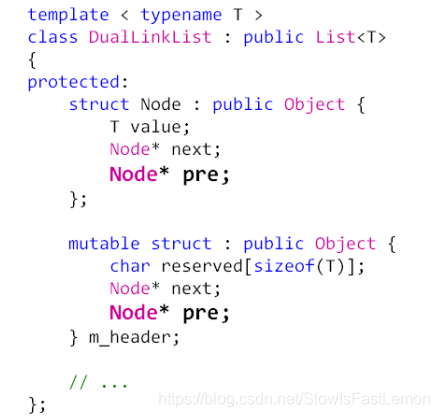1 单链表的缺陷
单链表具有单向性,只能从头结点开始高效访问链表中的数据元素。
缺陷: 如果需要逆向访问单链表中的数据元素将极其低效。

2 双向链表的实现
2.1 设计思路
在单链表的结点中增加一个指针pre,用于指向当前结点的前驱结点。

2.2 双向链表的继承层次结构

2.3 DualLinkList的定义

2.4 双向链表的特点
- 双向链表是为了弥补单链表的缺陷而重新设计的。
- 在概念上,双向链表不是单链表,没有继承关系。
- 双向链表中的游标能够直接访问当前结点的前驱和后继。
- 双向链表是线性表的最终实现(更贴近理论上的线性表)。
3 代码实现
DualLinkList.h
#ifndef DUALLINKLIST_H
#define DUALLINKLIST_H
#include "List.h"
#include "Exception.h"
namespace LemonLib
{
template < typename T >
class DualLinkList : public List<T>
{
protected:
struct Node : public Object
{
T value;
Node* next;
Node* pre;
};
/* 注意:当前结构体必须继承自Object类,否则会导致和Node的内存布局不同,直接抛出异常 */
mutable struct : public Object
{
char reserved[sizeof(T)];
Node* next;
Node* pre;
}m_header;
int m_length;
Node* m_current;
int m_step;
Node* position(int index) const
{
Node* ret = reinterpret_cast<Node*>(&m_header);
for (int i=0; i<index; i++)
{
ret = ret->next;
}
return ret;
}
virtual Node* create()
{
return new Node();
}
virtual void destroy(Node* pn)
{
delete pn;
}
public:
DualLinkList()
{
m_header.next = NULL;
m_header.pre = NULL;
m_length = 0;
m_current = NULL;
m_step = 0;
}
bool insert(int index, const T& e)
{
bool ret = (0 <= index) && (index <= m_length);
if (ret)
{
Node* node = create();
if (node != NULL)
{
Node* current = position(index);
Node* next = current->next;
node->value = e;
node->next = next; // 当前结点的next指针指向下一个结点
current->next = node;
if (current != reinterpret_cast<Node*>(&m_header)) // 当前插入的位置不是首结点
{
node->pre = current;
}
else
{
node->pre = NULL;
}
if (next != NULL) // 当前插入的不是最后一个结点
{
next->pre = node;
}
m_length++;
}
else
{
THROW_EXCEPTION(NoEnoughMemoryException, "No enough memory to inset element ...");
}
}
return ret;
}
bool insert(const T& e)// 插入到尾部
{
return insert(m_length, e);
}
bool remove(int index)
{
bool ret = (0 <= index) && (index < m_length);
if (ret)
{
Node* current = position(index);
Node* toDel = current->next;
Node* next = toDel->next;
current->next = toDel->next;
if (next != NULL)
{
next->pre = toDel->pre;
}
if (m_current == toDel)
{
m_current = toDel->next;
}
m_length--;
destroy(toDel);
}
return ret;
}
bool set(int index, const T& e)
{
bool ret = (0 <= index) && (index < m_length);
if (ret)
{
position(index)->next->value = e;
}
return ret;
}
bool get(int index, T& e) const
{
bool ret = (0 <= index) && (index < m_length);
if (ret)
{
e = position(index)->next->value;
}
return ret;
}
virtual T get(int index) const
{
T ret;
if (get(index, ret))
{
return ret;
}
else
{
THROW_EXCEPTION(InvalidParameterException, "Invalid parameter in get element...");
}
}
int find(const T& e) const
{
int ret = -1;
int index = 0;
Node* current = m_header.next;
while (current)
{
if (current->value == e)
{
ret = index;
break;
}
else
{
index++;
current = current->next;
}
}
return ret;
}
virtual bool move(int index, int step = 1)
{
bool ret = ((0 <= index) && (index < m_length) && (step > 0));
if (ret)
{
m_current = position(index)->next;
m_step = step;
}
return ret;
}
virtual bool end()
{
return (m_current == NULL);
}
virtual T current()
{
if (!end())
{
return m_current->value;
}
else
{
THROW_EXCEPTION(InvalidOperationException, "Invalid operation to get current value ...");
}
}
virtual bool next()
{
int i = 0;
while ((i < m_step) && (!end()))
{
m_current = m_current->next;
i++;
}
return (i == m_step);
}
virtual bool pre()
{
int i = 0;
while ((i < m_step) && (!end()))
{
m_current = m_current->pre;
i++;
}
return (i == m_step);
}
int length() const
{
return m_length;
}
void clear()
{
while (m_length > 0)
{
remove(0);
}
}
~DualLinkList()
{
clear();
}
};
}
#endif // DUALLINKLIST_H
main.cpp
#include <iostream>
#include "SmartPointer.h"
#include "Exception.h"
#include "Object.h"
#include "List.h"
#include "SeqList.h"
#include "StaticList.h"
#include "DynamicList.h"
#include "Array.h"
#include "StaticArray.h"
#include "DynamicArray.h"
#include "LinkList.h"
#include "StaticLinkList.h"
#include "Pointer.h"
#include "SmartPointer.h"
#include "SharedPointer.h"
#include "CircleList.h"
#include "DualLinkList.h"
using namespace std;
using namespace LemonLib;
int main()
{
DualLinkList<int> dl;
for (int i=0; i<5; i++)
{
dl.insert(0, i);
dl.insert(0, 8);
}
int ret = -1;
while ((ret = dl.find(8)) != -1)
{
dl.remove(ret);
}
#if 0 // 这样删除的意义不大
dl.move(dl.length()-1);
while (!dl.end())
{
if (dl.current() == 8)
{
dl.remove(dl.find(8));
}
else
{
dl.pre();
}
}
#endif
#if 1
for (dl.move(0); !dl.end(); dl.next())
{
cout << dl.current() << endl;
}
#endif
#if 0
for (dl.move(dl.length()-1); !dl.end(); dl.pre())
{
cout << dl.current() << endl;
}
#endif
#if 0
for (int i=0; i<5; i++)
{
cout << dl.get(i) << endl;
}
#endif
return 0;
}
4 开放性问题
DualLinkList和LinkList中存在很多完全一样的代码,如何进行重构降低代码的冗余性?冗余代码的出现是否意味着DualLinkList和LinkList之间应该是继承关系?
解决这个问题的方法就是DualLinkList继承LinkList,从而降低代码的冗余性。关于DualLinkList是否设计为LinkList的子类,这只是设计理念不同而已。
























 748
748

 被折叠的 条评论
为什么被折叠?
被折叠的 条评论
为什么被折叠?








